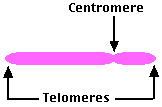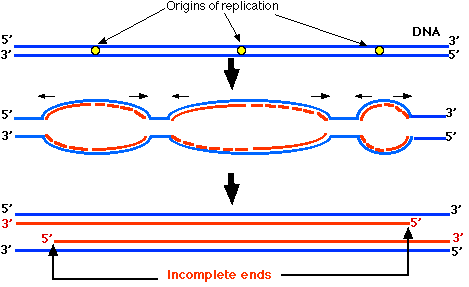Each eukaryotic chromosome consists of a single molecule of DNA associated with a variety of proteins.
Example: an average human chromosome contains a single molecule of DNA of about 150 million nucleotide pairs (150 x 106 bp). Stretched to its full length, this molecule would extend 5 cm. (about 2 inches). In the chromosome, this molecule is packed into a much more compact structure. The packing reaches its extreme during mitosis when this chromosome would condense to a structure some 5 µm long (a 10,000-fold reduction in length).
The DNA molecules in eukaryotic chromosomes are linear; i.e., have two ends. (This is in contrast to such bacterial chromosomes as that in E. coli that is a closed circle, i.e. has no ends.) The DNA molecule of a typical chromosome contains
 Telomeres are crucial to the life of the cell. They
Telomeres are crucial to the life of the cell. They
The telomeres of humans (and mice) consist of as many as 2000 repeats of the sequence 5' TTAGGG 3'.
5' .....TTAGGG TTAGGG TTAGGG TTAGGG TTAGGG TTAGGG..... 3' 3' .....AATCCC AATCCC AATCCC AATCCC AATCCC AATCCC..... 5'
DNA polymerase can only synthesize a new strand of DNA as it moves along the template strand in the 3' -> 5' direction. This works fine for the 3' -> 5' strand of a chromosome as the DNA polymerase can move uninterruptedly from an origin of replication until it meets another bubble of replication or the end of the chromosome. However, synthesis using the 5' -> 3' strand as the template has to be discontinuous. When the replication fork opens sufficiently, DNA polymerase can begin to synthesize a section of complementary strand - called an Okazaki fragment - working in the opposite direction. Later, DNA ligase stitches the Okazaki fragments together.
| See the discussion of DNA replication. |

In the figure on the right, the horizontal black arrows show the direction that the replication forks are moving. Wherever the replication fork of a strand is moving towards the 3' end, the newly-synthesized DNA (red) begins as Okazaki fragments (red dashes).
This continues until close to the end of the chromosome. However, the molecular requirements of the process are such that 5' end of each newly-synthesized strand cannot be completed. Thus each of the daughter chromosomes will have a shortened telomere.
It is estimated that human telomeres lose about 100 base pairs from their telomeric DNA at each mitosis.
This represents about 16 TTAGGG repeats. At this rate, after 125 mitotic divisions, the telomeres would be completely gone.
Is this why normal somatic cells are limited in the number of mitotic divisions before they die out?
Telomeres are important so their steady shrinking with each mitosis might impose a finite life span on cells. This, in fact, is the case. Normal (non-cancerous) cells do not grow indefinitely when placed in culture.
| See Cancer Cells in Culture for a discussion of the differences between normal and cancerous cells grown in culture. |
Cells removed from a newborn infant and placed in culture will go on to divide almost 100 times. Well before the end, however, their rate of mitosis declines (to less than once every two weeks). Were my cells to be cultured (I am 67 years old), they would manage only a couple of dozen mitoses before they ceased dividing and died out.
Could shrinkage of telomeres be a clock that determines the longevity of a cell lineage?
It turns out that these cells are able to maintain the length of their telomeres. They do so with the aid of an enzyme telomerase.
Telomerase is an enzyme that adds telomere repeat sequences to the 5' end of DNA strands. By lengthening the strand prior to replication, cells with active telomerase are able to compensate for telomere shortening during DNA replication.
Telomerase:However, when normal somatic cells are transformed in the laboratory with DNA expressing telomerase, they continue to divide by mitosis long after their normal life span is over. And they do so without any further shortening of their telomeres. This remarkable demonstration (reported by Bodnar et. al. in the 16 January 1998 issue of Science) provides the most compelling evidence yet that telomerase and maintenance of telomere length are the key to cell immortality.
Most cancers arise from somatic cells. But one of the crucial features that distinguishes a cancer cell from a normal somatic cell is its ability to divide indefinitely. It turns out that most cancer cells have regained the ability to synthesize telomerase and thus are able to prevent further shortening of their telomeres.
Perhaps agents that prevent the expression of the gene for telomerase - or prevent the action of the enzyme - will provide a new class of weapons in the fight against cancer.
| Discussion of this procedure used with children suffering from severe combined immunodeficiency (SCID) |
One problem with this approach is that the cells - like all normal somatic cells - are mortal. After a series of mitotic divisions, they die out. That is the reason the children required periodic fresh infusions of their transformed T cells.
What if their cells could be transformed not only with the therapeutic gene but also with an active telomerase gene? This should give them an unlimited life span.
But if cancer cells regain the ability to make telomerase, might not the reverse be true; that cells transformed with an active telomerase gene might become cancerous?
Perhaps not. The cells described by Bodnar et. al. in the 16 January 1998 issue of Science have continued to grow in culture for another year and have been subjected to a number of tests to see if they have acquired any properties of cancer cells in culture.| See Cancer Cells in Culture |
The now-famous sheep Dolly was cloned using a nucleus taken from an adult sheep cell that had been growing in culture. The cell donor was 6 years old, and its cells had been growing in culture for several weeks.
| Link to discussion of the technique that produced Dolly. |
What about Dolly's telomeres? Analysis of telomere length in Dolly's cells reveals that they are only 80% as long as in a normal one-year-old sheep. Not surprising since the nucleus that created Dolly had been deprived of telomerase for many generations.
Two other sheep - cloned from embryonic, not adult, cells - also had shortened telomeres although not as short as Dolly's. Perhaps the length of time the cells spent in culture before they were used accounts for this.
Does this mean that Dolly is doomed to a shortened life? Probably not. She seems healthy and has even had babies of her own She will probably live a normal life span before her chromosomes give out. But her short telomeres do add another question to the debate about cloning mammals from adult cells.
| Welcome&Next Search |